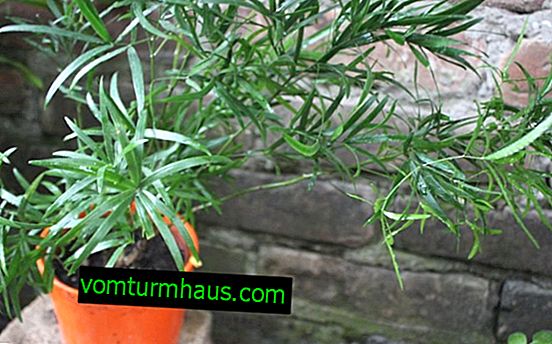Features of the reproduction of asparagus at home
A beautiful ampelous bush of asparagus is in demand when decorating residential or office premises. The plant is distinguished by a thick cap of needle shoots, unpretentiousness, longevity and ease of care. About how to propagate asparagus, we will tell in this review.
Did you know? The ancient Romans believed that the berries of asparagus officinalis improve the ability to eloquence, therefore, they were recommended to be used by great speakers and preachers.
Why breed asparagus?
Asparagus belongs to the genus Asparagus, which has more than 200 plants. Some of them are wild. Some are herbs, while others are shrubs. In indoor floriculture, only a few representatives of this species are grown:
- cirrus asparagus, or setacius;

- common asparagus;

- carapace asparagus.

Being a perennial, asparagus can grow in one pot for quite a long time - up to 20 years. The first 2 years he throws attractive stems resembling a fern. All shoots grow from the rhizome. If a new shoot grows, the old one dies. A cropped shoot does not provide new growth points. And this is the main feature - after a while it will look ugly, having several not very magnificent shoots. To enjoy lush flowering, it must be propagated, planting new plants instead of old ones.
Important! Red berries on indoor asparagus are poisonous and can cause digestive problems. Keep the plant away from children and animals at this time.
When is it best to breed asparagus?
Propagate the plant in early spring. At this time, a new growing season begins. It is suitable for growing representatives of asparagus indoors, and for planting in the garden. On street planting, you should know that asparagus is winter-hardy. They tolerate even soil frosts.
Plant propagation methods
You can grow new plants by sowing seeds of berries obtained in the fall, or by dividing the roots and twigs in the spring when new growth begins. Both methods produce healthy new plants with minimal effort.

How to grow asparagus from seeds?
Asparagus fern berries contain from one to three seeds that can be used for propagation. If you have berries, then sowing is advisable to carry out immediately after picking them. This period is likely to fall in the second half of winter. But if you do not have seeds, they can also be purchased at the store.
Important! Do not be nervous if you do not see seedlings. It will take them about 49 days to germinate. And it also depends on how well you rubbed them with a file.
Seed Planting Technology:
- Open the berries by removing the pulp and remove the black seeds from them. Rinse the seeds in water.
- Dry and rub with a metal file to break the dense outer coating and stimulate germination. This process is called scarification.
- Soak them in a bowl of hot (+ 75 ° C) water for 24 hours.
- Fill a small pot with soil mixture. It is made from sand, humus and peat, mixed in equal proportions.
- Moisten the soil.
- Sow the seeds at a depth of approximately two times the width in the prepared soil.
- Cover the pot with polyethylene to prevent loss of moisture.
- Install in a place where the air temperature is +23 ... + 29 ° С.
- Water as soon as the soil dries.
- When the sprouts appear, remove the film.
Subsequently, young plants are provided with an indirect but bright light throughout the day. They will also need an air temperature of about + 21 ° C, but not lower than + 15 ° C.
Video: asparagus seed propagation
Reproduction by dividing the bush
By dividing the bush, the plant is planted in the spring at the beginning of the growing season. To do this, you need a new pot for the second plant and soil. Typical soil composition should include humus, sand and leafy soil. There should be as much sheet land as sand and humus together. After combining the components, sterilize them using high temperature - this can be heating or pouring soil for several hours with boiling water.
You will be interested to learn about home care for the asparagus of Meyer and Sprenger.
Bush propagation technology:
- Dig a bush if it is a street variety of asparagus, or remove a plant from a pot.
- Remove that part of the earth that makes it difficult to see the roots.
- You should have a root ball in your hands.
- Cut it into two parts with a clean knife.
- Now you have 2 parts, each of which has its own branches and roots.
- Plant these pieces to the same depth at which they grew earlier.
- Water the soil completely so that the roots can straighten.

Cuttings
Propagation by cuttings is considered the most difficult method. But the main thing to keep in mind is that not all asparagus can reproduce in this way, so if you are not sure if this will be correct for your plant, it is better to propagate it by dividing the bush.
Important! Always wear gloves when handling asparagus because parts of the plant, including berries, can irritate the skin.
Propagation technology by cuttings:
- Prepare a pot and a mixture of sand and humus.
- Choose a healthy branch on the plant and cut it.
- Treat it with a growth stimulator, according to the instructions for the drug.
- Place the soil mixture in the pot and water it.
- Make a hole in the sand and install a branch there.
- Compact the soil around the handle.
- Place the pot for rooting in a place where there will be enough indirect light, the air temperature is above + 21 ° C and there are no drafts.
- Maintain a constant level of moisture around the seedling.
- When it forms the root system, it can be planted in a pot with constant soil.

Plant Transplant Features
Like ferns, asparagus can grow in one place for several years. A transplant is needed if the root system is closely in the pot, or the nutritional properties of the soil are exhausted.
Did you know? Asparagus has been used as a houseplant since the 19th century. Although it was known to botanists before, it was not distributed as a home.
Step-by-step transplant instructions:
- Choose a pot with large drainage holes below. It should be several centimeters wider in diameter than the one in which the plant is now.
- Carefully remove the asparagus from the old pot. Try not to damage the root system.
- Fill a new pot with a prepared mixture of fertile soil, sand and peat.
- Put some of the soil in the pot, and then set the root ball there.
- Add the mixture on the sides and compact it.
- Pour asparagus so that excess water drains into the pan.
Video: Asparagus transplant
Follow-up care
Subsequent care for asparagus, as well as for other plants, consists of:
- ensuring the correct microclimate: air temperature, lighting, humidity;
- glaze;
- top dressing.
| Lighting | It grows well in bright indirect light. The window may be east, west or north. In low light, growth slows down, leaves turn yellow and fall off. |
| Watering | Watering is necessary if the soil is 50% dry after the previous watering. In summer, provide more frequent watering. |
| Fertilizer | Weekly from spring to autumn (during the growing season) they are fed with balanced fertilizer with an equal ratio of nitrogen, phosphorus and potassium. You can also use fertilizer for non-flowering plants. |
| Temperature and humidity | Temperature +12 ... + 24 ° С. Humidity - not lower than 40%. The optimum humidity is 50%. |
| Pests | Asparagus can attack mealybug, spider mites, aphids, thrips. Use a mild solution of insecticidal soap to get rid of pests. |
| The soil | The soil should be light and well aerated. It can consist of peat, sand, sheet land. |
| Pruning | The plant does not need it. But if the leaf turns yellow, it is cut as close to the surface of the soil as possible. |
| Dormant care | In winter, asparagus has a dormant period. Watering is reduced to a minimum. Fertilizers do not apply. |
Reproduction of asparagus, as well as caring for it, are not difficult tasks, so if you decide to grow this wonderful houseplant, knowing the rules for caring for it, you will not have difficulties.






